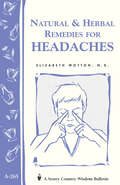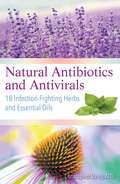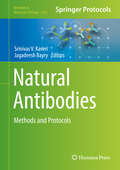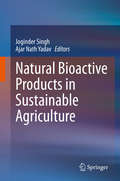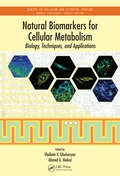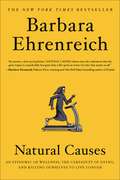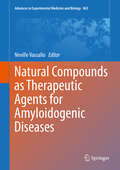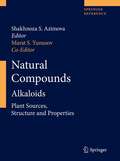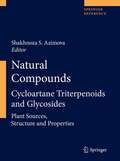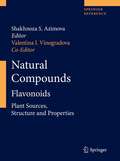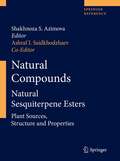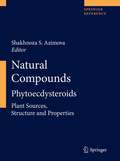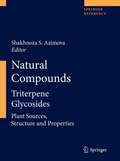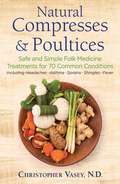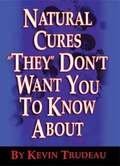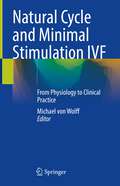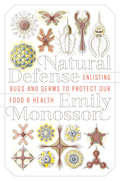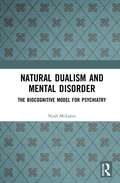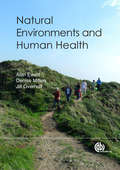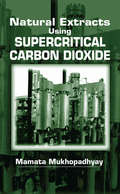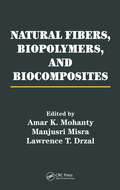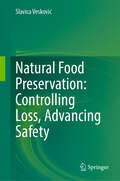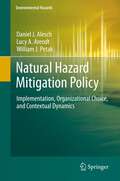- Table View
- List View
Natural & Herbal Remedies for Headaches: Storey's Country Wisdom Bulletin A-265 (Storey Country Wisdom Bulletin Ser.)
by Elizabeth Wotton N.D.Headaches, which range from mere annoyance to debilitating pain, are the most common health complaint in North America. Over-the-counter medications offer only temporary relief, and prescription drugs can cause serious side effects. Wouldn't you love to know how to treat - and prevent - your headaches effectively, safely, and naturally? In Natural & Herbal Remedies for Headaches, Elizabeth Wotton, a licensed naturopathic physician, explains the nature of headaches and offers all-natural preventives and treatments. She'll teach you how to: Figure out what kind of headache you're havingIdentify what's triggering your headachesSupplement your diet with headache-fighting nutrientsUse soothing herbal teas, tinctures, and baths to feel better fastBanish headaches from your life!
Natural Antibiotics and Antivirals: 18 Infection-Fighting Herbs and Essential Oils
by Christopher VaseyExplains how to use medicinal herbs and essential oils to fight infectious illness, strengthen the immune system, and combat antibiotic resistance • Presents 18 of the most potent antibiotic and antiviral herbs and one beehive remedy, propolis, detailing how to use them and what illnesses each is best suited to treat • Reveals how natural antibiotics have antiviral properties, lack side effects, and have no adverse effects on non-targeted bacteria, such as intestinal flora • Also includes info on restoring gut health with probiotics, strengthening your immune system to become less receptive to infections, and supporting natural antibiotics with detox treatments Nature offers us many natural antibiotics from the plant kingdom that work powerfully against germs while also being gentle on the body. Knowledge of these safe and natural antibiotics and antivirals is more crucial now than ever as modern antibiotics become less and less effective due to the growing threat of antibiotic-resistant germs. Natural antibiotics even offer an opportunity to reverse antibiotic resistance by reducing the use of pharmaceutical antibiotics to only the most critical cases. In this practical guide, Christopher Vasey presents 18 of the most potent antibiotic and antiviral herbs from around the world and one beehive remedy, propolis. He details how to use them effectively as mother tinctures and essential oils as well as what illnesses each is best suited to treat. Drawing on the latest research, he explains how microbes can’t build resistance against these natural substances due to the many molecules in their make-up and their large spectrum of action in the body, which makes them effective against viruses as well. He reveals that, unlike pharmaceutical antibiotics and antivirals whose list of side effects grows in proportion to their strength, natural antibiotics generally lack any malignant side effects and have no adverse effects on non-targeted bacteria, such as intestinal flora. The author also includes information on probiotics to restore gut health after the use of pharmaceutical antibiotics, ways to strengthen your immune system and become less receptive to infections, and guidance on detox treatments to support the natural antibiotics as they work. He also provides an index of more than 50 common ailments and diseases with the most effective medicinal plants and essential oils to use in each case. Offering a way to break free from the threat of antibiotic-resistant germs and improve the body’s immune system and internal terrain, this guide gives each of us the ability to fight infections naturally.
Natural Antibodies
by Jagadeesh Bayry Srinivas V. KaveriThis volume looks at the role of natural antibodies in pathogen elimination, cell survival, inflammation, cancer, and autoimmunity. The chapters in this book cover numerous topics, such as isolation of natural antibodies; methods for separating natural antibodies from human plasma, saliva, breast milk, and gastrointestinal fluids; functional properties of natural antibodies such as anti-tumor cytotoxic activity, and hydrolysis and dissolution of their target antigens; their utility in serological diagnosis of microbial antigens; and the role of natural antibodies in inhibiting viral vectors in the absence of prior exposure to the virus. Written in the highly successful Methods in Molecular Biology series format, chapters include introductions to their respective topics, lists of the necessary materials and reagents, step-by-step, readily reproducible laboratory protocols, and tips on troubleshooting and avoiding known pitfalls. Practical and thorough, Natural Antibodies: Methods and Protocols is a valuable resource for researchers and experts who are interested in further studies of natural antibodies.
Natural Bioactive Products in Sustainable Agriculture
by Joginder Singh Ajar Nath YadavThis book discusses various aspects of bioactive natural products employed in the agrochemical and agriculture sectors. It covers the use of plants, microorganisms, and microbial metabolites as eco-friendly, cost-effective, and sustainable alternatives to chemicals in the field of agriculture. Written by active researchers and academics, the book highlights state-of-art products in the field, as well as the gaps, challenges, and obstacles associated with the use of plants, microbes and their products. Given its scope, it is a valuable resource for the scientific community and professionals in enterprises wanting insights into the latest developments and advances in the context of biological products, including their applications, traditional uses, modern practices, and strategies to harness their full potential.
Natural Biomarkers for Cellular Metabolism: Biology, Techniques, and Applications (Series in Cellular and Clinical Imaging)
by Vladimir V. Ghukasyan Ahmed A. HeikalFrom the Lab to Clinical Settings-Advances in Quantitative, Noninvasive Optical DiagnosticsNoninvasive fluorescence imaging techniques, novel fluorescent labels, and natural biomarkers are revolutionizing our knowledge of cellular processes, signaling and metabolic pathways, the underlying mechanisms for health problems, and the identification of n
Natural Causes: An Epidemic of Wellness, the Certainty of Dying, and Killing Ourselves to Live Longer
by Barbara Ehrenreich<P>Bestselling author of Nickel and Dimed, Barbara Ehrenreich explores how we are killing ourselves to live longer, not better. <P>A razor-sharp polemic which offers an entirely new understanding of our bodies, ourselves, and our place in the universe, Natural Causes describes how we over-prepare and worry way too much about what is inevitable. One by one, Ehrenreich topples the shibboleths that guide our attempts to live a long, healthy life -- from the importance of preventive medical screenings to the concepts of wellness and mindfulness, from dietary fads to fitness culture. <P>But Natural Causes goes deeper -- into the fundamental unreliability of our bodies and even our "mind-bodies," to use the fashionable term. Starting with the mysterious and seldom-acknowledged tendency of our own immune cells to promote deadly cancers, Ehrenreich looks into the cellular basis of aging, and shows how little control we actually have over it. We tend to believe we have agency over our bodies, our minds, and even over the manner of our deaths. But the latest science shows that the microscopic subunits of our bodies make their own "decisions," and not always in our favor. <P>We may buy expensive anti-aging products or cosmetic surgery, get preventive screenings and eat more kale, or throw ourselves into meditation and spirituality. But all these things offer only the illusion of control. How to live well, even joyously, while accepting our mortality -- that is the vitally important philosophical challenge of this book. <P>Drawing on varied sources, from personal experience and sociological trends to pop culture and current scientific literature, Natural Causes examines the ways in which we obsess over death, our bodies, and our health. Both funny and caustic, Ehrenreich then tackles the seemingly unsolvable problem of how we might better prepare ourselves for the end -- while still reveling in the lives that remain to us. <P><b>A New York Times Bestseller</b>
Natural Compounds as Therapeutic Agents for Amyloidogenic Diseases
by Neville VassalloThis edited volume concerns a group of devastating neurological disorders that share a common pathological mechanism, namely the aggregation and deposition of insoluble, proteinaceous lesions, termed 'amyloid'. Examples of cerebral amyloid disorders include common neurodegenerative diseases like Alzheimer's disease-related dementia and Parkinson's disease, as well as other less prevalent conditions like Huntington's disease, cerebral amyloid angiopathy and the transmissible prion disorders. A disease-modifying therapeutic agent is still lacking for all these diseases, and there are no approved therapies that target amyloid formation directly. Nevertheless, a large and complex group of natural aromatic compounds known as polyphenols are rapidly emerging as potentially potent anti-amyloidogenic agents. This book collectively presents a considerable body of experimental and epidemiological evidence from peer-reviewed scientific publications that support a role for natural compounds and herbal extracts in the chemoprevention and therapy of amyloidogenic disorders. Each contribution is written by scientific experts in the relevant field; chapters are devoted to Mediterranean diet and olive oil phenols, traditional Chinese medicine, herbal extracts, polyphenols (with a particular emphasis on epigallocatechin-3-gallate) and bi-flavonoids, amongst others. The topic of this book is relevant to a wide audience, from academia and university students in the biological and chemical sciences, to physicians and allied health professionals, as well as people working in the nutraceutical industry.
Natural Compounds: Alkaloids
by Shakhnoza S. Azimova Marat S. Yunusov'Natural Compounds: Plant Sources, Structure and Properties' details the properties of over 7,500 chemical compounds of pharmacological interest found in plants. Each volume systematically covers occurrence of the compounds in plants, illustrations of chemical structures plus physical-chemical, spectral, and pharmacological data. Entries are indexed by plant name, subject, and pharmacological property. This provides unique coverage of information on compounds isolated from some 3,000 plants, including many from central Asia and Russia, that are not well known elsewhere. The entries for each compound share a similar format. The entries are preceded by tabulated information on the occurrence of the compounds in plants etc. The highly experienced team of compilers from the renowned Institute of the Chemistry of Plant Substances in Tashkent have expertly assessed the international literature and include data only when confident of its validity, e.g. excluding data where measurement processes cause degradation of the original compound.
Natural Compounds: Cycloartane Triterpenoids and Glycosides
by Shakhnoza S. Azimova'Natural Compounds: Plant Sources, Structure and Properties' details the properties of over 7,500 chemical compounds of pharmacological interest found in plants. Each volume systematically covers occurrence of the compounds in plants, illustrations of chemical structures plus physical-chemical, spectral, and pharmacological data. Entries are indexed by plant name, subject, and pharmacological property. This provides unique coverage of information on compounds isolated from some 3,000 plants, including many from central Asia and Russia, that are not well known elsewhere. The entries for each compound share a similar format. The entries are preceded by tabulated information on the occurrence of the compounds in plants etc. The highly experienced team of compilers from the renowned Institute of the Chemistry of Plant Substances in Tashkent have expertly assessed the international literature and include data only when confident of its validity, e.g. excluding data where measurement processes cause degradation of the original compound.
Natural Compounds: Flavonoids
by Shakhnoza S. Azimova Valentina I. Vinogradova'Natural Compounds: Plant Sources, Structure and Properties' details the properties of over 7,500 chemical compounds of pharmacological interest found in plants. Each volume systematically covers occurrence of the compounds in plants, illustrations of chemical structures plus physical-chemical, spectral, and pharmacological data. Entries are indexed by plant name, subject, and pharmacological property. This provides unique coverage of information on compounds isolated from some 3,000 plants, including many from central Asia and Russia, that are not well known elsewhere. The entries for each compound share a similar format. The entries are preceded by tabulated information on the occurrence of the compounds in plants etc. The highly experienced team of compilers from the renowned Institute of the Chemistry of Plant Substances in Tashkent have expertly assessed the international literature and include data only when confident of its validity, e.g. excluding data where measurement processes cause degradation of the original compound.
Natural Compounds: Natural Sesquiterpene Esters. Part 1 and Part 2
by Shakhnoza S. Azimova Ashraf I. Saidkhodzhaev'Natural Compounds: Plant Sources, Structure and Properties' details the properties of over 7,500 chemical compounds of pharmacological interest found in plants. Each volume systematically covers occurrence of the compounds in plants, illustrations of chemical structures plus physical-chemical, spectral, and pharmacological data. Entries are indexed by plant name, subject, and pharmacological property. This provides unique coverage of information on compounds isolated from some 3,000 plants, including many from central Asia and Russia, that are not well known elsewhere. The entries for each compound share a similar format. The entries are preceded by tabulated information on the occurrence of the compounds in plants etc. The highly experienced team of compilers from the renowned Institute of the Chemistry of Plant Substances in Tashkent have expertly assessed the international literature and include data only when confident of its validity, e.g. excluding data where measurement processes cause degradation of the original compound.
Natural Compounds: Phytoecdysteroids
by Shakhnoza S. Azimova'Natural Compounds: Plant Sources, Structure and Properties' details the properties of over 7,500 chemical compounds of pharmacological interest found in plants. Each volume systematically covers occurrence of the compounds in plants, illustrations of chemical structures plus physical-chemical, spectral, and pharmacological data. Entries are indexed by plant name, subject, and pharmacological property. This provides unique coverage of information on compounds isolated from some 3,000 plants, including many from central Asia and Russia, that are not well known elsewhere. The entries for each compound share a similar format. The entries are preceded by tabulated information on the occurrence of the compounds in plants etc. The highly experienced team of compilers from the renowned Institute of the Chemistry of Plant Substances in Tashkent have expertly assessed the international literature and include data only when confident of its validity, e.g. excluding data where measurement processes cause degradation of the original compound.
Natural Compounds: Triterpene Glycosides. Part 1 and Part 2
by Shakhnoza S. Azimova'Natural Compounds: Plant Sources, Structure and Properties' details the properties of over 7,500 chemical compounds of pharmacological interest found in plants. Each volume systematically covers occurrence of the compounds in plants, illustrations of chemical structures plus physical-chemical, spectral, and pharmacological data. Entries are indexed by plant name, subject, and pharmacological property. This provides unique coverage of information on compounds isolated from some 3,000 plants, including many from central Asia and Russia, that are not well known elsewhere. The entries for each compound share a similar format. The entries are preceded by tabulated information on the occurrence of the compounds in plants etc. The highly experienced team of compilers from the renowned Institute of the Chemistry of Plant Substances in Tashkent have expertly assessed the international literature and include data only when confident of its validity, e.g. excluding data where measurement processes cause degradation of the original compound.
Natural Compresses and Poultices: Safe and Simple Folk Medicine Treatments for 70 Common Conditions
by Christopher VaseyA step-by-step naturopathic guide to using the hands-on natural healing method of compresses and poultices • Explains how to use compresses and poultices for 70 common ailments and chronic conditions, such as migraine, asthma, acne, sinusitis, earache, arthritis, sprains, hives, shingles, anxiety, insomnia, mastitis, muscle pains, bronchitis, and more • Details what type of compress or poultice to use for each ailment, whether to use it hot or cold, where on the body to apply it, and for how long • Explores the physiological reasons these simple remedies are so effective and how they work not only for acute ailments and illness but also for chronic conditions Valued by herbalists, midwives, and mothers throughout history, compresses and poultices are gentle yet highly effective natural remedies you can safely use at home. Easily made from materials you already have in your kitchen, such as ice cubes, herbs, cabbage leaves, lemon slices, clay, or beeswax, these simple preparations can quickly ease pain and inflammation, relieve congestion and edema, lower fever, drain abscesses, activate circulation, calm muscle spasms, and trigger the body’s natural self-healing abilities. In this step-by-step naturopathic guide to compresses and poultices, Christopher Vasey, N.D., shows how to use these time-tested folk remedies to treat 70 common ailments and conditions, including headache, asthma, acne, sinusitis, earache, arthritis, sprains, hives, shingles, anxiety, insomnia, mastitis, constipation, diarrhea, muscle pains, bronchitis, and more. He explains that a compress is a cloth soaked in hot or cold infused water and applied to a specific part of the body. A poultice works similarly, but instead of a liquid extract, the healing material is made into a paste and applied directly to the body. He details what type of compress or poultice to use for each ailment, whether to use it hot or cold, where on the body to apply it, and for how long. Vasey also explores the physiological reasons these simple remedies can be so effective, such as how some treatments trigger healing through the nerves, others cause the skin to absorb or expel substances, and others have beneficial effects on the body’s internal chemistry. He reveals how compresses and poultices not only can alleviate acute symptoms, but are equally effective for dealing with chronic conditions. Offering an indispensable complement to your home first aid kit, this book provides you with a hands-on way to bring relief and healing to yourself and your loved ones.
Natural Cycle and Minimal Stimulation IVF: From Physiology to Clinical Practice
by Michael Von WolffThis practical book focuses on the most recent advances in natural cycle and minimal stimulation in vitro fertilization (IVF).The volume presents the steps that need to be followed to successfully perform these techniques and covers all aspects and competences involved.The book provides information on physiology of folliculogenesis, ovulation, oocytes and luteal phase and based on this information on clinical practice of stimulation, ovulation induction and inhibition, follicle aspiration and luteal phase support in natural cycle and minimal stimulation IVF. In addition costs, risks, success rates and several treatment protocols are provided.An overview of large European, Japanese and American programs and the discussion of clinical cases will complete the coverage of the topic.This practical and easy-to-use guide is a valuable resource for all clinicians performing any kind of IVF techniques.
Natural Defense: Enlisting Bugs and Germs to Protect Our Food and Health
by Emily MonossonFor more than a century, we have relied on chemical cures to keep our bodies free from disease and our farms free from bugs and weeds. We rarely consider human and agricultural health together, but both are based on the same ecology, and both are being threatened by organisms that have evolved to resist our antibiotics and pesticides. Patients suffer fromC.diff, a painful, potentially lethal gut infection associated with multiple rounds of antibiotics; orange groves rot from insect-borne bacteria; and the blight responsible for the Irish potato famine outmaneuvers fungicides. Our chemicals are failing us.Fortunately, scientists are finding new solutions that work with, rather than against, nature. Emily Monosson explores science's most innovative strategies, from high-tech gene editing to the ancient practice of fecal transplants. There are viruses that infect and bust apart bacteria; vaccines engineered to better provoke our natural defenses; and insect pheromones that throw crop-destroying moths into a misguided sexual frenzy. Some technologies will ultimately fizzle; others may hold the key to abundant food and unprecedented health. Each represents a growing understanding of how to employ ecology for our own protection.Monosson gives readers a peek into the fascinating and hopeful world of natural defenses. Her book is full of optimism, not simply for particular cures, but for a sustainable approach to human welfare that will benefit generations to come.
Natural Disasters in the Ottoman Empire
by Yaron AyalonThis book explores the history of natural disasters in the Ottoman Empire and the responses to them on the state, communal, and individual levels. Yaron Ayalon argues that religious boundaries between Muslims and non-Muslims were far less significant in Ottoman society than commonly believed. Furthermore, the emphasis on Islamic principles and the presence of Islamic symbols in the public domain were measures the state took to enhance its reputation and political capital occasional discrimination of non-Muslims was only a by-product of these measures. This study sheds new light on flight and behavioral patterns in response to impending disasters by combining historical evidence with studies in social psychology and sociology. Employing an approach that mixes environmental and social history with the psychology of disasters, this work asserts that the handling of such disasters was crucial to both the rise and the fall of the Ottoman Empire. "
Natural Dualism and Mental Disorder: The Biocognitive Model for Psychiatry
by Niall McLarenThis book presents an integrative, dualist model of mental disorder for psychiatry, as a counter to the so-called "biomedical" approach that dominates the field today. Starting with the humanist concept that mental disorder is real, it uses a computational approach to build a genuinely bio-psycho-social model. This shows that mental disorder is primarily psychological in nature, not biological. The historical background extends as far as Descartes, and proceeds via some of the revolutionary thinkers who have shaped modern society. In particular, it builds on the work of George Boole, Alan Turing and Claude Shannon to construct a radically new concept of the mind as a real, informational space which, for better off for worse, can malfunction. It extends this idea to build models of personality, of personality disorder, and then of mental disorder. Finally, the concepts are tested against a variety of themes from other fields to show its generality. Based in the philosophy of science and of mind, this work represents a radical departure from anything in the history of psychiatry. Its purpose is to provide a formal, articulated model of mental disorder to fill the theoretical void at the core of modern psychiatry. This book is written for medical students and recent graduates, for psychiatrists, psychologists, social workers and, broadly, anybody with an interest in human affairs, such as philosophy, politics and other related fields.
Natural Environments and Human Health
by Alan Ewert Jill Overholt Jillisa Overholt Denise MittenThe role natural environments play in human health and wellbeing is attracting increasing attention. There is growing medical evidence that access to the natural environment can prevent disease, aid recovery, tackle obesity and improve mental health. This book examines the history of natural environments being used for stress-reduction, enjoyment, aesthetics and catharsis, and traces the development of the connection between humans and the environment, and how they impact our personal and collective health.
Natural Environments and Human Health
by Jill Overholt Dr Alan Ewert Professor Denise MittenThe role natural environments play in human health and wellbeing is attracting increasing attention. There is growing medical evidence that access to the natural environment can prevent disease, aid recovery, tackle obesity and improve mental health. This book examines the history of natural environments being used for stress-reduction, enjoyment, aesthetics and catharsis, and traces the development of the connection between humans and the environment, and how they impact our personal and collective health.
Natural Extracts Using Supercritical Carbon Dioxide
by Mamata MukhopadhyaySynthesizing research from a wide variety of sources, this work offers a convenient guide to a clean, safe, inexpensive, non-toxic, non-polluting solvent that performs better than most conventional solvents. Natural Extracts Using Supercritical Carbon Dioxide reviews recent development in the technology and its applications to the food, flavor, fra
Natural Fibers, Biopolymers, and Biocomposites
by Manjusri Misra Amar K. Mohanty Lawrence T. DrzalNatural/Biofiber composites are emerging as a viable alternative to glass fiber composites, particularly in automotive, packaging, building, and consumer product industries, and becoming one of the fastest growing additives for thermoplastics. Natural Fibers, Biopolymers, and Biocomposites provides a clear understanding of the present state
Natural Food Preservation: Controlling Loss, Advancing Safety
by Slavica VeskovicControlling food spoilage is critical not only to maintaining public health, but also to minimizing food loss, which in turn has broad impacts on the economy and the environment. Consumers today, concerned with both human and ecological health, are adamant that the elimination of risk for foodborne disease need not come at the cost of nutritional quality or ecological considerations. Moreover, a large factor towards the continued threat of foodborne illness is the fact that the responsible bacteria are increasingly resistant to conventional antibiotics. Considering that nature provides abundant antimicrobial compounds, it is salutary to assess the role that these compounds can play in fighting foodborne pathogens. As a result of these demands and considerations, natural antimicrobials are beginning to gain ground over their synthetic counterparts in industrial food safety processes. The success of these antimicrobial agents in individual settings has demonstrated that safe food doesnot have to mean highly processed or less sensorially satisfying food. Natural Preservation: Safety, Losses and Protection will discuss the economic and ecological benefits of a food industry moving away from dependence on synthetic chemicals and preservatives, and illustrate the impact that the extension of shelf life for the minimization of food waste can have on food insecurity across the globe. Readers can expect an overview of safety that considers economic as well as ecological interests, and assesses each stage of the food processing chain for its role in improving the nutritional, physicochemical and sensory values of the product. This includes a discussion of lactic acid bacteria (LAB) and their secondary metabolic products, bacteriocins, and how their application to fermentation processes can expand the possibilities for natural approaches to food safety, with major implications for global health and ecology. This volume demonstrates the integral role bio-protectors can play in production processes, promoting their potential while also outlining the necessity for appropriate laboratory, industrial and medical evaluations to ensure their efficacy and win their approval by regulatory bodies. The perspectives offered will be valuable to researchers, policymakers and industry professionals with investments in building a more sustainable and more equitable food system.
Natural Hazard Mitigation Policy
by William J. Petak Daniel J. Alesch Lucy A. ArendtThe negative consequences of natural hazard events are staggering and growing. Governments are acting to increase community resilience, reduce losses, and facilitate recovery, but these actions do not always yield anticipated consequences. This book is a compelling interdisciplinary analysis of California's efforts to ensure that acute care hospitals survive earthquakes and continue to function in the aftermath. The book weaves together several threads essential to understanding the effectiveness of public policies intended to reduce the consequences of natural hazard events: public policy design and administration, the hazard mitigation investment decision made by targeted organizations, and contextual dynamics. "A terrific study of shortfalls in the implementation of risk-reduction policy -- highly readable, full of insights, and very policy relevant." Peter J. May, Donald R. Matthews Distinguished Professor of American Politics, University of Washington, Seattle USA "This is an exceptional book by three of the leading hazard mitigation researchers and must reading for both scholars and practitioners in the field." William A. Anderson, National Research Council, National Academy of Sciences.
